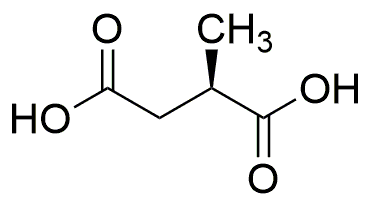(R)-(+)-Methylsuccinic acid is widely utilized in research focused on:
- Pharmaceutical Development: This compound serves as an important intermediate in the synthesis of various pharmaceuticals, enhancing the efficiency of drug formulation processes.
- Food Industry: It acts as a flavoring agent and preservative, improving the taste and shelf life of food products while ensuring safety and compliance with food regulations.
- Biochemical Research: Researchers use it as a chiral building block in the synthesis of biologically active compounds, facilitating studies in drug design and development.
- Polymer Manufacturing: It contributes to the production of biodegradable polymers, offering a more sustainable alternative to traditional plastics, which is increasingly important in environmental applications.
- Aromatherapy and Fragrance: The compound is utilized in the formulation of fragrances, providing a unique scent profile that appeals to consumers in personal care products.
General Information
Properties
Safety and Regulations
Applications
(R)-(+)-Methylsuccinic acid is widely utilized in research focused on:
- Pharmaceutical Development: This compound serves as an important intermediate in the synthesis of various pharmaceuticals, enhancing the efficiency of drug formulation processes.
- Food Industry: It acts as a flavoring agent and preservative, improving the taste and shelf life of food products while ensuring safety and compliance with food regulations.
- Biochemical Research: Researchers use it as a chiral building block in the synthesis of biologically active compounds, facilitating studies in drug design and development.
- Polymer Manufacturing: It contributes to the production of biodegradable polymers, offering a more sustainable alternative to traditional plastics, which is increasingly important in environmental applications.
- Aromatherapy and Fragrance: The compound is utilized in the formulation of fragrances, providing a unique scent profile that appeals to consumers in personal care products.
Documents
Safety Data Sheets (SDS)
The SDS provides comprehensive safety information on handling, storage, and disposal of the product.
Product Specification (PS)
The PS provides a comprehensive breakdown of the product’s properties, including chemical composition, physical state, purity, and storage requirements. It also details acceptable quality ranges and the product's intended applications.
Certificates of Analysis (COA)
Search for Certificates of Analysis (COA) by entering the products Lot Number. Lot and Batch Numbers can be found on a product’s label following the words ‘Lot’ or ‘Batch’.
*Catalog Number
*Lot Number
Certificates Of Origin (COO)
This COO confirms the country where the product was manufactured, and also details the materials and components used in it and whether it is derived from natural, synthetic, or other specific sources. This certificate may be required for customs, trade, and regulatory compliance.
*Catalog Number
*Lot Number
Safety Data Sheets (SDS)
The SDS provides comprehensive safety information on handling, storage, and disposal of the product.
DownloadProduct Specification (PS)
The PS provides a comprehensive breakdown of the product’s properties, including chemical composition, physical state, purity, and storage requirements. It also details acceptable quality ranges and the product's intended applications.
DownloadCertificates of Analysis (COA)
Search for Certificates of Analysis (COA) by entering the products Lot Number. Lot and Batch Numbers can be found on a product’s label following the words ‘Lot’ or ‘Batch’.
*Catalog Number
*Lot Number
Certificates Of Origin (COO)
This COO confirms the country where the product was manufactured, and also details the materials and components used in it and whether it is derived from natural, synthetic, or other specific sources. This certificate may be required for customs, trade, and regulatory compliance.


